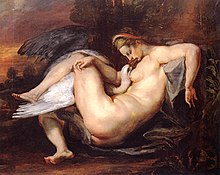Leda (Michelangelo)
| Leda |
| Copy after Michelangelo , 1529/1530 |
| Oil on canvas, 105.4 × 121 cm |
| National Gallery (London) |
The Leda is one of the most famous motifs from Michelangelo Buonarroti and the Italian Renaissance . The original has not been preserved, the copy in the National Gallery comes from the circle of Rosso Fiorentino .
In Greek mythology approaches Zeus of Leda in the form of a swan. Pictorial representations of the seduction scene have been preserved from antiquity, for example a wall painting in Pompei or a statue in Athens. In the Renaissance, Filarete was probably the first to take up the motif for a relief on the bronze door of St. Peter's Basilica in Rome. Another lost painting by Leonardo da Vinci shows a standing Leda (1503–05). She and Michelangelo's reclining Leda are the basis of many variations by later painters.
History of the painting
It is one of the few panel paintings that Michelangelo painted. It is known through Giorgio Vasari that the picture was painted in tempera . It was created in 1529/30 by order of Alfonso d'Este von Ferrara , who was never to receive it. Legend has it that the Duke's envoy behaved tactlessly towards Michelangelo, whereupon he gave the picture to his pupil Antonio Mini . In 1532 Mini brought the picture together with two boxes full of Michelangelo's drawings to the French court in Fontainebleau , where he deposited it for Francis I as a possible interested party. Later he is said to have actually bought the picture. It probably stayed in Fontainebleau until 1643, when it was under Louis XIII. , probably at the instigation of Anna of Austria because of his immoral portrayal of the Minister François Sublet for destruction. Whether he followed the instructions or kept the picture himself is unclear, because Francesco Milizia reports that it still existed in 1740, albeit in poor condition. Then all traces of the painting are lost.
Copies

Numerous copies and engravings, of which the picture in the National Gallery in London is best known, provide a rough impression of the picture, which has now disappeared . For a long time this was considered a possible candidate for the lost original picture, but is now believed to be a copy made in the circle of Rosso Fiorentino . Other well-known painted copies are in Venice ( Museo Correr ) and Dresden ( Gemäldegalerie Alte Meister ). The latter is an early work by Peter Paul Rubens . We know well-known engravings from the picture by Cornelis de Bos and Nicolaus Beartrizet . The engraving by Beatrizet seems to reproduce the original most precisely because it also shows the twins Castor and Pollux mentioned in old sources as well as the broken egg.
literature
- Charles de Tolnay , Ettore Camesaca: Classics of Art. The painted work of Michelangelo . Kunstkreis Luzern - Freudenstadt - Vienna, 1966.
- Harald Olbrich (Ed.): Lexicon of Art . EA Seemann Verlag, Leipzig, 1987-1994, Vol. 4, p. 257.
